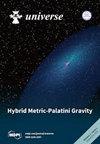Graviton Physics: A Concise Tutorial on the Quantum Field Theory of Gravitons, Graviton Noise, and Gravitational Decoherence
IF 2.5
4区 物理与天体物理
Q2 ASTRONOMY & ASTROPHYSICS
引用次数: 0
Abstract
The detection of gravitational waves in 2015 ushered in a new era of gravitational wave (GW) astronomy capable of probing the strong field dynamics of black holes and neutron stars. It has opened up an exciting new window for laboratory and space tests of Einstein’s theory of classical general relativity (GR). In recent years, two interesting proposals have aimed to reveal the quantum nature of perturbative gravity: (1) theoretical predictions on how graviton noise from the early universe, after the vacuum of the gravitational field was strongly squeezed by inflationary expansion; (2) experimental proposals using the quantum entanglement between two masses, each in a superposition (gravitational cat, or gravcat) state. The first proposal focuses on the stochastic properties of quantum fields (QFs), and the second invokes a key concept of quantum information (QI). An equally basic and interesting idea is to ask whether (and how) gravity might be responsible for a quantum system becoming classical in appearance, known as gravitational decoherence. Decoherence due to gravity is of special interest because gravity is universal, meaning, gravitational interaction is present for all massive objects. This is an important issue in macroscopic quantum phenomena (MQP), underlining many proposals in alternative quantum theories (AQTs). To fully appreciate or conduct research in these exciting developments requires a working knowledge of classical GR, QF theory, and QI, plus some familiarity with stochastic processes (SPs), namely, noise in quantum fields and decohering environments. Traditionally a new researcher may be conversant in one or two of these four subjects: GR, QFT, QI, and SP, depending on his/her background. This tutorial attempts to provide the necessary connective tissues between them, helping an engaged reader from any one of these four subjects to leapfrog to the frontier of these interdisciplinary research topics. In the present version, we shall address the three topics listed in the title, excluding gravitational entanglement, because, despite the high attention some recent experimental proposals have received, its nature and implications in relation to quantum gravity still contain many controversial elements.引力子物理学引力子、引力子噪声和引力退相干量子场论简明教程
2015 年对引力波的探测开创了引力波(GW)天文学的新时代,它能够探测黑洞和中子星的强场动力学。它为爱因斯坦经典广义相对论(GR)的实验室和空间测试打开了一扇令人兴奋的新窗口。近年来,有两个有趣的建议旨在揭示微扰引力的量子本质:(1)理论预测早期宇宙中引力场真空被膨胀强烈挤压后的引力子噪声;(2)实验建议利用两个质量之间的量子纠缠,每个质量都处于叠加(引力猫,或 gravcat)状态。第一项建议侧重于量子场(QFs)的随机特性,第二项建议则引用了量子信息(QI)的关键概念。一个同样基本和有趣的想法是询问引力是否(以及如何)导致量子系统在表面上变得经典,即所谓的引力退相干。引力导致的退相干特别令人感兴趣,因为引力是普遍存在的,也就是说,所有大质量物体都存在引力相互作用。这是宏观量子现象(MQP)中的一个重要问题,也是替代量子理论(AQT)中许多提议的基础。要充分理解或研究这些令人兴奋的发展,需要对经典 GR、QF 理论和 QI 有一定的了解,还要熟悉随机过程(SP),即量子场和退相环境中的噪声。传统上,新研究人员可能精通这四个学科中的一个或两个:GR、QFT、QI 和 SP,这取决于他/她的背景。本教程试图在它们之间提供必要的连接组织,帮助来自这四个学科中任何一个学科的读者跃升到这些跨学科研究课题的前沿。在本版本中,我们将讨论标题中列出的三个主题,但不包括引力纠缠,因为尽管最近的一些实验建议受到高度关注,但其性质和对量子引力的影响仍包含许多有争议的因素。
本文章由计算机程序翻译,如有差异,请以英文原文为准。
求助全文
约1分钟内获得全文
求助全文
来源期刊

Universe
Physics and Astronomy-General Physics and Astronomy
CiteScore
4.30
自引率
17.20%
发文量
562
审稿时长
24.38 days
期刊介绍:
Universe (ISSN 2218-1997) is an international peer-reviewed open access journal focused on fundamental principles in physics. It publishes reviews, research papers, communications, conference reports and short notes. Our aim is to encourage scientists to publish their research results in as much detail as possible. There is no restriction on the length of the papers.
 求助内容:
求助内容: 应助结果提醒方式:
应助结果提醒方式:


